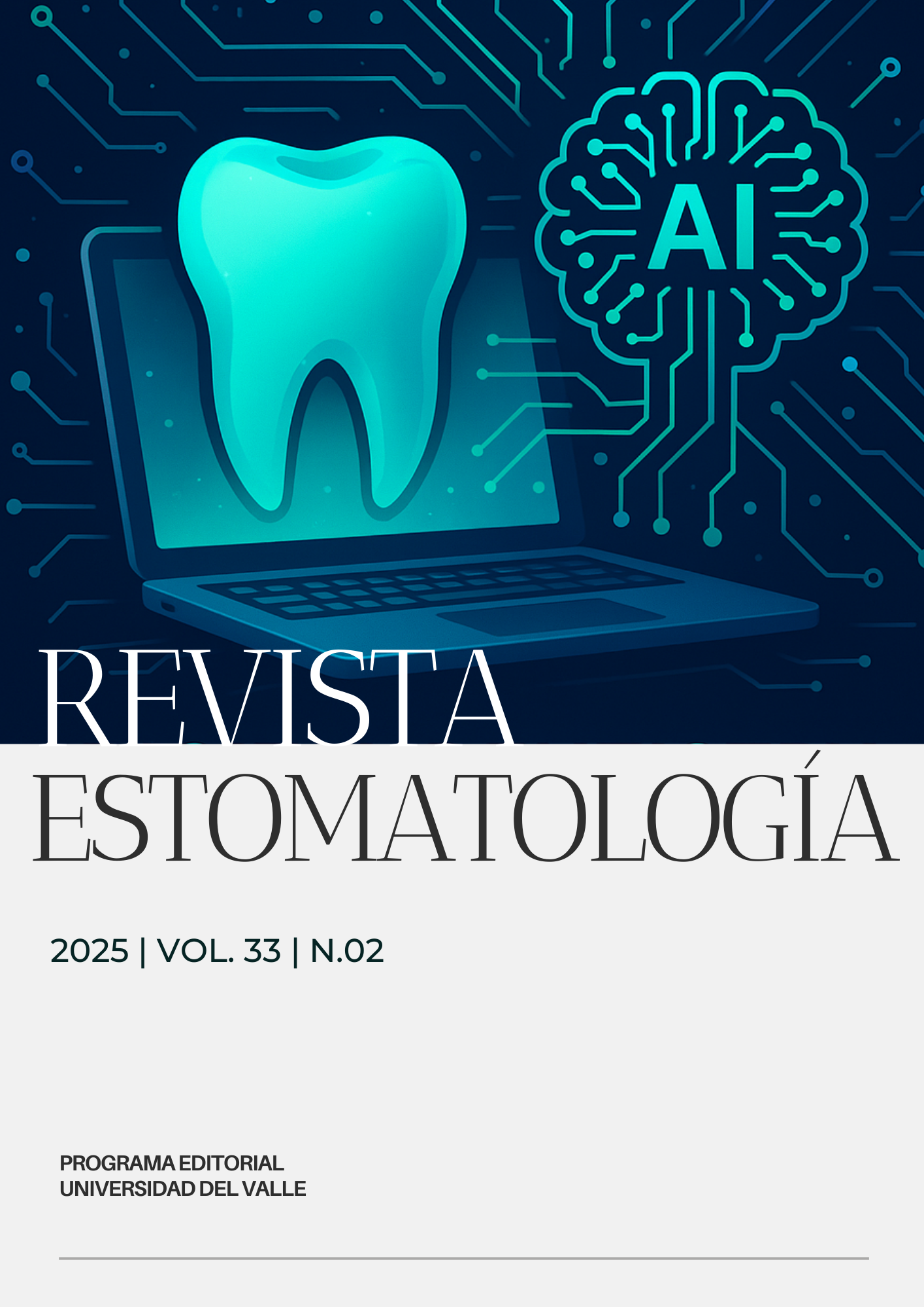Prevalence and Morphological Patterns of Mandibular Asymmetries in a Mexican Population: A CBCT-Based Analysis
Keywords:
Mandibular asymmetry, cone-beam computed tomography, craniofacial morphology, hemimandibular elongation, glenoid fossa asymmetryMain Article Content
Background: Mandibular asymmetries are complex craniofacial conditions that can impact facial esthetics, function, and psychosocial well-being. Accurate diagnosis is crucial for planning individualized orthodontic and surgical treatment.
Objective: To evaluate the prevalence, severity, and morphological classifications of mandibular asymmetries in a Mexican population using cone-beam computed tomography (CBCT).
Materials and methods: A cross-sectional study was conducted involving 231 patients aged 9–65 years from the orthodontic clinic at Universidad Autónoma de San Luis Potosí. Mandibular asymmetry was assessed using CBCT scans, categorized by the deviation of the mandibular symphysis (DMS) as mild (0–2 mm), moderate (2.1–5 mm), or severe (>5 mm). Severe asymmetries were further classified according to Obwegeser and Makek’s system. Descriptive and inferential statistics were used to analyze differences in condylar and mandibular dimensions.
Results: Among 231 participants, 18 cases (7.8%) presented with severe mandibular asymmetry. Asymmetry of the glenoid fossa (AGF) was the most common classification (38.89%), followed by hemimandibular elongation (HE) at 27.78%. Severe deviations predominantly occurred on the right side (61.11%). No statistically significant differences were observed between male and female participants in terms of asymmetry type or severity.
Conclusion: CBCT imaging provides detailed visualization for detecting and classifying mandibular asymmetries. AGF and HE were the most frequent morphological types in this Mexican population, with a predominance of right-sided deviation. These findings underscore the need for population-specific diagnostic protocols and highlight the clinical value of 3D imaging in asymmetry evaluation.
Keywords: Mandibular asymmetry; cone-beam computed tomography; craniofacial morphology; hemimandibular elongation; glenoid fossa asymmetry.
Zhu Y, Fu X, Zhang L, Zheng S, Wen A, Xiao N, et al. A mathematical algorithm of the facial symmetry plane: Application to mandibular deformity 3D facial data. J Anat. 2022;240(3):556-66. Doi: https://doi.org/10.1111/joa.13564
Xie Y, Zeng R, Yan J, Yan T, Tan J. Introducing surface-to-surface matching technique to evaluate mandibular symmetry: a retrospective study. Heliyon. 2022;8(7). Doi: https://doi.org/10.1016/j.heliyon.2022.e09914
Ng WH, Goh BT, Lim AAT, Tan MH. Mandibular asymmetry: Is there a difference in the bone and soft tissue thickness between both sides? Oral Surg Oral Med Oral Pathol Oral Radiol. 2022;134(6):e299-306. Doi: https://doi.org/10.1016/j.oooo.2022.05.010
Iyer J, Hariharan A, Cao UMN, Tran SD. Acquired facial, maxillofacial, and oral asymmetries-a review highlighting diagnosis and management. Symmetry. 2021;13(9):1661. Doi: https://doi.org/10.3390/sym13091661
Atiba PM, Omotoso BR, Madaree A, Lazarus L. Hemifacial microsomia: a scoping review on progressive facial asymmetry due to mandibular deformity. Oral Maxillofac Surg. 2024;1-15. Doi: https://doi.org/10.1007/s10006-024-01276-5
Almeida LE, Zammuto S, Lopez DF. Evaluating Surgical Approaches for Hemimandibular Hyperplasia Associated with Osteochondroma: A Systematic Literature Review. J Clin Med. 2024;13(22):6988. Doi: https://doi.org/10.3390/jcm13226988
Prasad B. Condylar hyperplasia: A road not taken. J Indian Soc Pedod Prev Dent. 2024;42.
Šimunović L, Lapter Varga M, Negovetić Vranić D, Čuković-Bagić I, Bergman L, Meštrović S. The Role of Malocclusion and Oral Parafunctions in Predicting Signs and Symptoms of Temporomandibular Disorders-A Cross-Sectional Study. Dent J. 2024;12(7):213. Doi: https://doi.org/10.3390/dj12070213
Chia MS, Naini FB, Gill DS. The aetiology, diagnosis and management of mandibular asymmetry. Orthod Update. 2008;1(2):44-52. Doi: https://doi.org/10.12968/ortu.2008.1.2.44
La Rosa S, Leonardi R, Ronsivalle V, Cicciù M, Giudice AL. Radiographic and diagnostic approaches for mandibular asymmetries in orthodontic practice: A narrative review. 2024
Marques FBC, de Lima LS, Oliveira PLE, Magno MB, Ferreira DMTP, de Castro ACR, et al. Are temporomandibular disorders associated with facial asymmetry? A systematic review and meta‐analysis. Orthod Craniofac Res. 2021;24(1):1-16. Doi: https://doi.org/10.1111/ocr.12404
Leung M, Leung Y. Three-dimensional evaluation of mandibular asymmetry: a new classification and three-dimensional cephalometric analysis. Int J Oral Maxillofac Surg. 2018;47(8):1043-51. Doi: https://doi.org/10.1016/j.ijom.2018.03.021
Obwegeser HL, Makek MS. Hemimandibular hyperplasia-hemimandibular elongation. J Maxillofac Surg. 1986;14:183-208. Doi: https://doi.org/10.1016/S0301-0503(86)80290-9
López DF, Botero JR, Muñoz JM, Cárdenas-Perilla R, Moreno M. Are there mandibular morphological differences in the various facial asymmetry etiologies? A tomographic three-dimensional reconstruction study. J Oral Maxillofac Surg. 2019;77(11):2324-38. Doi: https://doi.org/10.1016/j.joms.2019.05.020
Babczyńska A, Kawala B, Sarul M. Genetic factors that affect asymmetric mandibular growth-A systematic review. Symmetry. 2022;14(3):490. Doi: https://doi.org/10.3390/sym14030490
Evangelista K, Valladares-Neto J, Silva MAG, Cevidanes LHS, de Oliveira Ruellas AC. Three-dimensional assessment of mandibular asymmetry in skeletal Class I and unilateral crossbite malocclusion in 3 different age groups. Am J Orthod Dentofacial Orthop. 2020;158(2):209-20. Doi: https://doi.org/10.1016/j.ajodo.2019.08.010
Thiesen G, Gribel BF, Freitas MPM, Oliver DR, Kim KB. Mandibular asymmetries and associated factors in orthodontic and orthognathic surgery patients. Angle Orthod. 2018;88(5):545-51. Doi: https://doi.org/10.2319/111517-785.1
Bakri MMH, Vishvnathaiah S, Bakmani HF, Hakami AJ, Zaidan MS, Dighriri MA, et al. Prevalence of Mandibular Asymmetries in the Pediatric Population of Jazan: A Radiographic Analytical Study. Heliyon. 2024. Doi: https://doi.org/10.2139/ssrn.4661737
Ramirez-Yañez GO, Stewart A, Franken E, Campos K. Prevalence of mandibular asymmetries in growing patients. Eur J Orthod. 2011;33(3):236-42. Doi: https://doi.org/10.1093/ejo/cjq057
Miresmaeili A, Salehisaheb H, Farhadian M, Borjali M. Mandibular asymmetry in young adult patients with unilateral posterior crossbite: A controlled retrospective CBCT study. Int Orthod. 2021;19(3):433-44. Doi: https://doi.org/10.1016/j.ortho.2021.05.003
Vespasiano V, Klop C, Mulder CS, Koolstra JH, Lobé NH, Beenen LFM, et al. Normal variation of mandibular asymmetry in children. Orthod Craniofac Res. 2023;26(3):524-30. Doi: https://doi.org/10.1111/ocr.12639
Hikosaka Y, Koizumi S, Kim YI, Adel M, Nadim M, Hikita Y, et al. Comparison of mandibular volume and linear measurements in patients with mandibular asymmetry. Diagnostics. 2023;13(7):1331. Doi: https://doi.org/10.3390/diagnostics13071331
Hlatcu AR, Galan E, Milicescu Jr Ștefan, Teodorescu E, Ionescu E. An Evaluation of the Ramus Mandibular Asymmetry on the Panoramic Radiography. Appl Sci. 2023;13(13):7645. Doi: https://doi.org/10.3390/app13137645
Downloads

This work is licensed under a Creative Commons Attribution-NonCommercial-NoDerivatives 4.0 International License.
Los autores/as conservan los derechos de autor y ceden a la revista el derecho de la primera publicación, con el trabajo registrado con la licencia de atribución de Creative Commons, que permite a terceros utilizar lo publicado siempre que mencionen la autoría del trabajo y a la primera publicación en esta revista.

